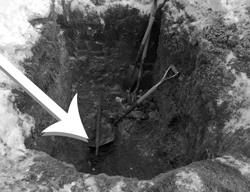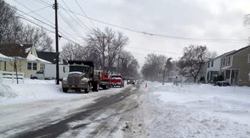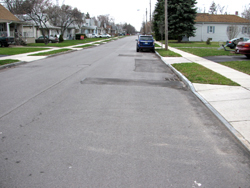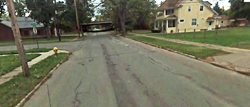Frozen Water-Gate... Icy Deception Real Blame for Frozen Lines Belongs to Water Board
By Frank Parlato
A recent spate of media reports described how 10 homes in the 500 block of 72nd St. in LaSalle were without water for more than a week.
All of the stories quoted Niagara Falls Mayor Paul Dyster.
"Having water lines freeze during a cold winter is not at all an unusual situation," said Mayor Dyster.
But why 10 houses on a single block?
The Buffalo News reported that Dyster said "there were about 'six theories' about what may have happened and it would be premature to discuss the possibilities."
Dyster said the city will conduct an investigation to see what caused this cluster of homes to be more susceptible to low temperatures.
"There are a number of theories that have been advanced, but, again, I'm trying not to speculate on what that could be about until we look at it in some great detail," he said.
The Niagara Gazette reported that "Dyster, Council Chairman Charles Walker, Councilman Andrew Touma, Director of Code Enforcement Dennis Virtuoso and members of his staff visited residents who had called the city and conferred on a plan to restore water service."
Dyster declared a "limited state of emergency," put out a bid to hire a plumber to thaw out the pipes and hopefully find the cause.
"We don't know what it is, but we believe there is a systemic cause for this," Dyster said to the local media.
The city council approved an allocation of $45,000 to pay for plumbing services and $2,153 to pay for code enforcement overtime.
Gross PHC won the bid, thawing out the pipes with electrical current for $2,920 at each house - a temporary fix.
The Niagara Falls Water Board was quick to disavow any responsibility for the problem, writing to residents that, by law, frozen pipes are their [homeowners] responsibility.
The Niagara Falls Reporter uncovered information that suggests it is the Water Board's fault.
A penny wise and dollar foolish Water Board, we might add.
Let's look at what really may have led to the problem.
In 2010, the Dyster administration designed and performed a $2.6 million full-depth road reconstruction of 72nd Street between Buffalo Avenue and Niagara Falls Blvd.
Accadia Site Contracting won the bid for the project.
But only half the street - from Buffalo Ave. to Stephenson St.- got new water lines. The other half, from Stephenson to Niagara Falls Blvd, did not get new water lines.
The city put $2.6 million into reconstructing the road and, according to the contractors who did the work, for about $300,000 more, they could have had all new water lines.
It is no coincidence that the section of street that did not get new water lines is where the lines froze..
But it was not the city it was the Water Board that decided not to install new water lines from Stephenson to Niagara Falls Blvd.
This was their mistake, it seems, since the old water lines under the road are too shallow, being as little as two feet below the surface.
In a climate like ours, water lines should be buried below the freeze line - more than 48-52 inches below ground.
So why didn't it freeze before?
For one, this was a very cold winter.
For another, until the road was redone, the old water lines were better insulated.
When the road was redone, the soil was replaced by stone, and now the frost penetrates quicker and deeper.
It is ironic: Part of what caused 72nd St. to sink and deteriorate -causing the need for the road reconstruction - was that there was not enough stone or gravel to hold it up.
Underneath the road was sandy soil that shifts, sinks and settles.
The water lines, however, although close to the road, were packed in this soil and this kept water from surrounding them and causing them to freeze.
"The problem is we had to put the stone in, in order to support the roadway, which was why the road was in the condition it was in before, because of the improper foundation beneath it," said Anthony Mallone, a licensed engineer, who was project manager for Accadia Site Construction.
Paul Marinaccio, president of Accadia, added, "A lot of times when we do these jobs, the dirt has been around the water lines for 30, 40, 50, 100 years. It keeps everything tight. Now we come digging along and take the pressure of the dirt away and [the water lines] start leaking because they're deteriorated."
So what should have been done?
"Install a new water line, excavate it down to a depth that would have been below the freeze line," Mallone said.
Why didn't they do that?
"Because the Water Board had to come up with the money," answered Mallone.
Marinaccio said his company made the city and the Water Board aware of the problem.
"When we did the job, [we knew] the water line wasn't deep enough, plus it was leaking all over the place. I sent the city a letter saying that they should replace the water line and they said (the Water Board would not approve) the money. So when we dug, we had to dig on each side of the water line because the water line wasn't deep enough. We had to be careful when we rolled the stone, because it probably would have broken."
You told them the water line would cause a problem?
"Oh! It was leaking," Marinaccio said. "It was leaking all over the place. I don't remember how much (extra) they paid me to keep patching it because it was leaking."
Apparently, there are two scenarios for the future:
One is to dig up the road and put in a new, deeper water line, something that will cost double what it would have cost originally.
Mallone explained: "You need to redo the water line, re-cut the road, which is only 3½ years old. It's more of an issue now, to do all the inter-connects, run the new services to the main deck. Now you'll be replacing a portion of the sidewalk. It's going to be very costly."
"It might be a little more than $500,000 to do it right, now," Mallone added.
If the job is redone it will also leave "patch" marks on the otherwise new road.
The other option is to leave it alone and make sure residents with shallow water lines keep their water trickling constantly during the cold winter months.
"If you've got a little flow, it'll never freeze," Mallone said.
Water Board Executive Director Paul J. Drof said the houses on 72nd with the too shallow water lines, are being added to a program where homeowners are allowed to let water lines trickle from mid-December through March without being charged for all the added water they will use.
Finally, for the sake of disclosure, I am not unfamiliar with this subject since I built two roads in my lifetime, one a 1,450 foot road which I named Hidden Hollow, in Hamburg, and the other, in Clarence, which was an extension of Brookhaven Road. I not only paved, but installed water lines and sanitary sewer lines.
In my opinion, the main culprit was the Water Board in not doing the entire water line, and to a lesser degree, the Dyster administration perhaps could have been more forceful in insisting it should have been done.
When I built my roads, it was done with my own money. Any mistake I made would cost me. I was careful.
In the case of the Niagara Falls Water Board, it is the people's money. At the end of the day, there is no penalty for mistakes. No discipline for errors. This is, after, all, Niagara Falls.



